by Eric Meier
When attempting to identify a wood sample, it’s important to keep in mind the limitations and obstacles that are present in our task. Before starting, please have a look at The Truth Behind Wood Identification to approach the task in a proper mindset; I consider the linked article to be required reading for all those visiting my site with the intent of identifying wood.
1. Confirm it is actually solid wood.
Before proceeding too much farther into the remaining steps, it’s first necessary to confirm that the material in question is actually a solid piece of wood, and not a man-made composite or piece of plastic made to imitate wood.
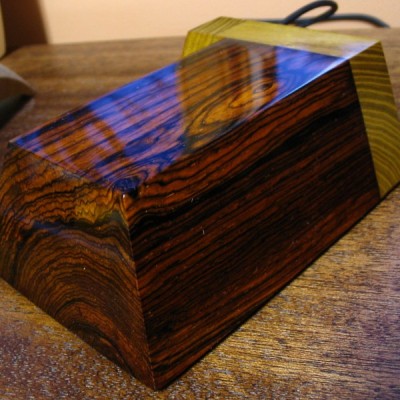
Can you see the end-grain?
Manufactured wood such as MDF, OSB, and particleboard all have a distinct look that is—in nearly all cases—easily distinguishable from the endgrain of real wood. Look for growth rings—formed by the yearly growth of a tree—which will be a dead-giveaway that the wood sample in question is a solid, genuine chunk of wood taken from a tree.
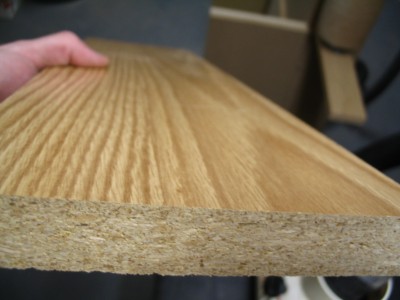
Is it veneered?
If you see a large panel that has a repeating grain pattern, it may be a veneer. In such cases, a very thin layer of real wood is peeled from a tree and attached to a substrate; sometimes the veneer can be one continuous repeating piece because it is rotary-sliced to shave off the veneer layer as the tree trunk is spun by machines. Assuming it is a real wood veneer with a distinct grain and texture—and not merely a piece of printed plastic—you may still be able to identify the outer veneer wood in question, but you should still realize that is it only a veneer and not a solid piece of wood.
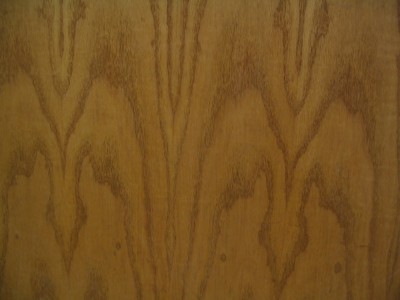
Is it painted or printed to look like wood?
Many times, especially on medium to large-sized flat panels for furniture, a piece of particleboard or MDF is either laminated with a piece of wood-colored plastic, or simply painted to look like wood grain. Many of today’s interior hardwood flooring planks are good examples of these pseudo-wood products: they are essentially a man-made material made of sawdust, glues, resins, and durable plastics.
2. Look at the color.
Some questions to immediately ask yourself:
Is the color of the wood natural, or is it stained?
If there is even a chance that the color isn’t natural, the odds are increased that the entire effort of identifying the wood will be in vain.
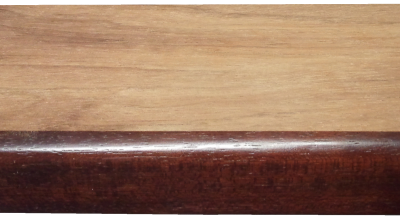
Is it weathered or have a patina?
Many woods, when left outside in the elements, tend to turn a bland gray color. Also, even interior wood also takes on a patina as it ages: some woods get darker, or redder, and some even get lighter or lose their color; but for the most part, wood tends to darken with age.
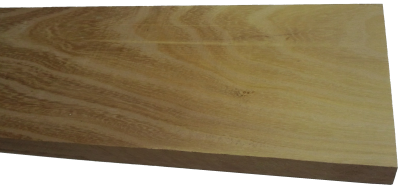
Is it possible to sand or plane the board to see the natural raw color of the wood?
The most predictable baseline to use when identifying wood is in a freshly sanded state. This eliminates the chances of a stain or natural aging skewing the color diagnosis of the wood.
3. Observe the wood grain.
If the wood is unfinished, then look at the texture of the grain. Ask yourself these questions:
Does the wood have an open, porous texture?
Most softwoods will be almost perfectly smooth with no grain indentations, while many common hardwoods have an open pore structure, such as oak or mahogany; though there are some hardwoods that are also smooth to the touch, such as maple.
Can you tell if the wood is quartersawn or plainsawn?
By observing the grain patterns, many times you can tell how the board was cut from the tree. Some wood species have dramatically different grain patterns from plainsawn to quartersawn surfaces. For instance, on their quartersawn surfaces, lacewood has large lace patterns, oak has flecks, and maple has the characteristic “butcher block” appearance.
Is there any figure or unusual characteristics, such as sapwood, curly or wild grain, burl/knots, etc.?
Some species of wood have figure that is much more common than in other species: for example, curly figure is fairly common in soft maple, and the curls are usually well-pronounced and close together. Yet when birch or cherry has a curly grain, it is more often much less pronounced, and the curls are spaced farther apart.
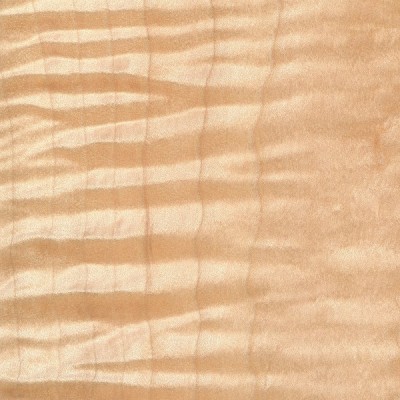
4. Consider the weight and hardness of the wood.
If it’s possible, pick the piece of wood up and get a sense of its weight, and compare it to other known wood species. Try gouging the edge with your fingernail to get a sense of its hardness. If you have a scale, you can take measurements of the length, width, and thickness of the wood, and combine them to find the density of the wood. This can be helpful to compare to other density readings found in the database. When examining the wood in question, compare it to other known wood species, and ask yourself these questions:
Is the wood dry?
Wood from freshly felled trees, or wood that has been stored in an extremely humid environment will have very high moisture contents. In some freshly sawn pieces, moisture could account for over half of the wood’s total weight! Likewise, wood that has been stored in extremely dry conditions of less than 25% relative humidity will most likely feel lighter than average.
How does the wood’s weight compare to other species?
Taking into account the size of the board, how does its weight compare to other benchmark woods? Is it heavier than oak? Is it lighter than pine? Look at the weight numbers for a few wood species that are close to yours, and get a ballpark estimate of its weight.
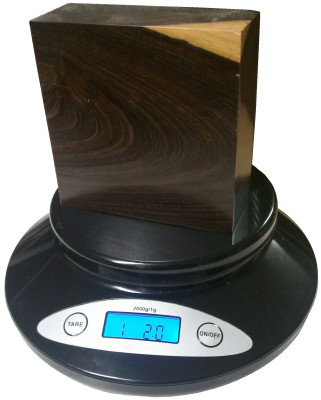
How hard is the wood?
Obviously softwoods will tend to be softer than hardwoods, but try to get a sense of how it compares to other known woods. Density and hardness are closely related, so if the wood is heavy, it will most likely be hard too. If the wood is a part of a finished item that you can’t adequately weigh, you might be able to test the hardness by gouging it in an inconspicuous area. Also, if it is used in a piece of furniture, such as a tabletop, a general idea of its hardness can be assessed by the number and depth of the gouges/dings in the piece given its age and use. A tabletop made of pine will have much deeper dents than a tabletop made of Oak. Additionally, you can always try the “fingernail test” as a rough hardness indicator: find a crisp edge of the wood, and with your fingernail try to push in as hard as you can and see if you’re able to make a dent in the wood.
5. Consider its history.
Many times we forget common sense and logic when attempting to identify wood. If you’ve got a piece of Amish furniture from Pennsylvania, chances are more likely that the wood will be made of something like black walnut or cherry, and not African wenge or jatoba. You might call it “wood profiling,” but sometimes it can pay to be a little prejudiced when it comes to wood identification. Some common-sense questions to ask yourself when trying to identify a piece of wood:
Where did it come from?
Knowing as much as you can about the source of the wood—even the smallest details—can be helpful. If the wood came from a wood pile or a lumber mill where all the pieces were from trees processed locally, then the potential species are immediately limited. If the wood came from a builder of antique furniture, or a boat-builder, or a trim carpenter: each of these occupations will tend to use certain species of woods much more often than others, making a logical guess much simpler.
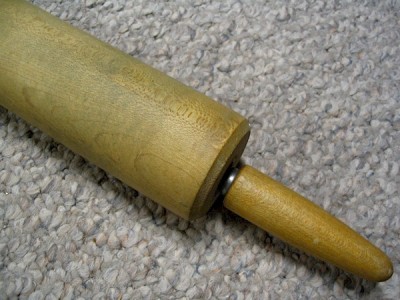
How old is it?
As with the wood’s source, its age will also help in identification purposes. Not only will it help to determine if the wood should have developed a natural patina, but it will also suggest certain species which were more prevalent at different times in history. For instance, many acoustic guitars made before the 1990s have featured Brazilian rosewood backs/sides, yet due to CITES restrictions placed upon that species, East Indian rosewood became a much more common species on newer guitars. (And this is a continuing shift as newer replacements are sought for rosewoods altogether.)
How large is the piece of wood?
Some species of trees are typically very small—some are even considered shrubs—while others get quite large. For instance, if you see a large panel or section of wood that’s entirely black, chances are it’s either painted, dyed, or stained: Gaboon ebony and related species are typically very small and very expensive.
What is the wood’s intended use?
Simply knowing what the wood was intended for—when considered in conjunction with where it came from and how old it is—can give you many clues to help identify it. In some applications, certain wood species are used much more frequently than others, so that you can make an educated guess as to the species of the wood based upon the application where it was used. For instance, in the United States: many older houses with solid hardwood floors have commonly used either red oak or hard maple; many antique furniture pieces have featured quartersawn white oak; many violins have spruce tops; many closet items used aromatic red cedar, and so forth. While it’s not a 100% guarantee, “profiling” the wood in question will help reduce the number of possible suspects, and aid in deducing the correct species.
6. Find the X-Factor.
Sometimes, after all the normal characteristics of a sample have been considered, the identity of the wood in question is still not apparent. In these instances—particularly in situations where a sample has been narrowed down to only a few possible remaining choices—it’s sometimes helpful to bring in specialized tests and other narrower means of identification.
The following techniques and recommendations don’t necessarily have a wide application in initially sorting out wood species and eliminating large swaths of wood species, but will most likely be of use only as a final step in special identification circumstances.
Odor
Believe it or not, freshly machined wood can have a very identifiable scent. When your eyes and hands can’t quite get a definitive answer, sometimes your nose can. Assuming there is no stain, finish, or preservative on or in the wood, quickly sand, saw, or otherwise machine a section of the wood in question, and take a whiff of the aroma.
Although new scents can be very difficult to express in words, many times the scent of an unknown wood may be similar to other known scents. For instance, rosewoods (Dalbergia spp.) are so named for their characteristic odor that is reminiscent of roses. Although difficult to directly communicate, with enough firsthand experience scents can become a memorable and powerful means of wood identification.
Fluorescence
While certain woods can appear basically identical to one another under normal lighting conditions, when exposed to certain wavelengths—such as those found in blacklights—the wood will absorb and emit light in a different (visible) wavelength. This phenomenon is known as fluorescence, and certain woods can be distinguished by the presence or absence of their fluorescent qualities. See the article Fluorescence: A Secret Weapon in Wood Identification for more information.
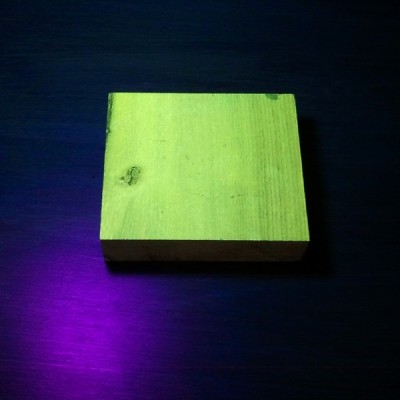
Chemical Testing
There are only a small number of chemical tests regularly used on wood, most of which are very specialized and were developed to help distinguish easily confused species with one another. They work by detecting differences in the composition of heartwood extractives. A chemical substance (called a reagent) is usually dissolved in water and applied to the wood surface: the surface is then observed for any type of chemical reaction (and accompanying color change) that may occur. Two of the most useful are the tests that are meant to separate Red and White Oak, and Red and Hard Maple.
Heartwood Extractives Leachability
Sometimes a wood species will have heartwood extractives that will be readily leachable in water and capable of conspicuously tinting a solution of water a specific color. For instance, the heartwood extractives contained in osage orange (Maclura pomifera) contain a yellowish-brown dye that is soluble in water. (This can sometimes be observed anecdotally when the wood is glued with a water-based adhesive: the glue’s squeeze-out is an unusually vibrant yellow.)
In a simple water extract color test, wood shavings are mixed with water in a vial, test tube, or other suitably small container, and the color of the water is observed after a few minutes. If the heartwood extractives are leachable by water, then a corresponding color change should quickly occur.
In addition to osage orange (Maclura pomifera), merbau (Intsia spp.), and rengas (Gluta spp. and Melanorrhoea spp.) are also noted for their readily leachable heartwood extractives. Because this property is quite uncommon, it can serve to quickly differentiate these woods from other lookalikes.
7. Look at the endgrain.
Perhaps no other technique for accurate identification of wood is as helpful and conclusive as the magnified examination of the endgrain. Frequently, it brings the identification process from a mostly intuitive, unscientific process into a predictable, repeatable, and reliable procedure.
Looking at the endgrain with a magnifier shouldn’t be a mystifying or esoteric art. In many cases, it’s nearly as simple as examining small newsprint under a magnifying glass. There are three components necessary to reap the full benefits contained in the endgrain:
I. A prepared surface.
When working with wood in most capacities, it becomes quickly apparent that endgrain surfaces are not nearly as cooperative or as easily worked as face grain surfaces. However, in this case, it is absolutely critical that a clear and refined endgrain surface is obtained.
For a quick glance of a softwood sample, a very sharp knife or razor blade can be used to take a fresh slice from the endgrain. However, in many denser species, especially in tropical hardwoods, one of the best ways to obtain a clear endgrain view is through diligent sanding. It’s usually best to begin with a relatively smooth saw cut (as from a fine-toothed miter saw blade) and proceed through the grits, starting at around 100, and working up to at least 220 or 320 grit, preferably higher for the cleanest view.
II. The right magnifier.
It need not be expensive, but whatever tool is used to view the endgrain should have adequate magnifying power. In most instances, 10x magnification is ideal, however, anything within the range of 8 to 15x magnification should be suitable for endgrain viewing. (Standard magnifying glasses are typically in the range of 2 to 4x magnification.)
These stronger magnifiers, sometimes called loupes, usually have a smaller viewing area than standard magnifying glasses. Fancier models—with built in lights, or larger viewing surfaces—are available at a premium; but the most basic models are usually only a few dollars.
III. A trained eye.
The third element that constitutes a proper endgrain examination is simply knowing what to look for. In analyzing the patterns, colors, shapes, and spacing of the various anatomical features, there is a veritable storehouse of information within the endgrain—all waiting to be unlocked. Yet, if these elements have not been pointed out and learned, the array of features will simply seem like an unintelligible jumble. The discipline of recognizing anatomical endgrain features is not easily summed up in a few sentences or even a few paragraphs, but it is nonetheless critical to the identification process. To this end, an in-depth look should be given to the various categories, divisions, and elements that constitute endgrain wood identification on the macroscopic level. (In this regard, macroscopic denotes what can be seen with a low-powered, 10x hand lens—without the aid of a microscope—rather than simply what can be seen with the naked eye.) Because the anatomy between softwoods and hardwoods is so divergent, each will be considered and examined separately:Still stumped?
If you have a mysterious piece of wood that you’d like identified, you’ve got a few options for next steps:USDA’s Forest Products Laboratory
You can mail your physical wood samples to the Center for Wood Anatomy Research.
Pros:
- Free
- Professional wood identification
Cons:
- Only available to US citizens
- Slow turnaround times (up to a month or more)
- Limited to three IDs per year
See their Wood ID Factsheet for more info.
Alden Identification Service
You can mail your physical wood samples (even small sections taken from antiques) to Alden Identification Service.
Pros:
- Professional wood identification
- Faster turnaround times (ranging from a few days to a week or two)
Cons:
- Paid service
See their ordering page for more info. (Note that Harry Alden has written several books while at USDA, including both Hardwoods and Softwoods of North America.)
Ask for help online
If the wood ID is merely a curiosity, or non-critical, you can post pictures of the wood in question.
Pros:
- Free
- No need to send physical samples
Cons:
- Greatly limited by the quality of the pictures provided
- Extra work usually required to get adequate clarity in photos
See article of Common US Hardwoods to help find the most commonly used woods.
Get the hard copy
 If you’re interested in getting all that makes The Wood Database unique distilled into a single, real-world resource, there’s the book that’s based on the website—the Amazon.com best-seller, WOOD! Identifying and Using Hundreds of Woods Worldwide. It contains many of the most popular articles found on this website, as well as hundreds of wood profiles—laid out with the same clarity and convenience of the website—packaged in a shop-friendly hardcover book.
If you’re interested in getting all that makes The Wood Database unique distilled into a single, real-world resource, there’s the book that’s based on the website—the Amazon.com best-seller, WOOD! Identifying and Using Hundreds of Woods Worldwide. It contains many of the most popular articles found on this website, as well as hundreds of wood profiles—laid out with the same clarity and convenience of the website—packaged in a shop-friendly hardcover book. 





Why I will no longer be replying to every wood ID request I’ve replied to literally thousands of wood ID requests on this site over the past 13+ years, but as the site’s popularity has grown, so has the time demands for ID on a daily basis. (Contrary to what some may seem to think, I am not some all-knowing wood wizard that can instantly ID your wood. It can actually take me a long time to sift through a lot of different resources.) Over the past few years, my backlog of pending wood species to be added to the… Read more »
Hi, I was offered a vintage sideboard for a very reasonable price, but I would like to know if it is worth the time and effort to refinish it. Could you please help me identify the wood the veneer is made of? (Because of the repeated pattern, I assume it is veneer). I didn’t have a chance to see the piece directly. I only have these poor-quality pictures. Thanks a lot.
Any ideas? Soft wood, kiln dried, aged yellowish color, tight side-grain, end grain appears to have growth rings. Realtively light weight.
We’ve come into several planks of rough-cut hardwood here in East Tennessee, most likely native to the area. I’ve made some beautiful projects from it. The color hints of walnut, but not quite dark enough and I don’t think there’s much walnut here. The picture of the square piece is darker because its been waxed. Any ideas?
Definitely looks like walnut to me.
Hi, I’m wondering what type of wood these are. They were in the walls of our house that was built 1909. Some of them was loadbearing. We live in Sweden. My original guess/hope was that these are oak but lacking knowledge and it might be pine.
It looks like a softwood like pine. I’m not sure what would’ve been common to use in Sweden, but definitely a softwood species of some sort.
Thanks for you help
Trying to find out what type of wood this is. Used as a base for a small table sculpture attached to it. Sculpture from 1960’s by Austin Productions Inc. No longer in business.
We recovered these wood planks from an old school built around 1900 in Maryland. We think pine or cedar maybe. It’s very heavy like oak though. Would appreciate any help.
Definitely a softwood of some sort like pine or fir. The surface isn’t smooth enough in the softer earlywood sections to see if there are resin canals, so a more precise ID isn’t possible with provided pictures.
Can anyone help identify this wood? It’s smooth and hard like maple but has those constant grain lines like an oak. I’m stumped…
Your instincts to distrust your ID of maple and oak are correct. The wood is ring porous (pores arranged in rows corresponding to each year’s growing season), which rules out maple. And the color and lack of larger rays also rules out oak. While I can’t say for sure from the pics given, I think the most likely candidates are either hickory or ash. There’s of course a handful of other ring porous hardwoods in your area, but those are the two most commonly seen that match your pics.
I can’t figure out this wood it washed up in Wilmington NC after a hurricane.
Looks like some pretty interesting stuff. I think it’d be helpful to see a closer, more finely-sanded view of the endgrain, particularly the endgrain area in the first picture where the wood is still red and not darkened. I can’t make out enough details with the pics as-is.
It smells like beef jerky.
Please re-try attaching latest round of pics, they didn’t come through.
Some more pics
Here is some better pics
Looks like a diffuse porous hardwood coming from a tropical climate. There are a lot of possibilities, but given the color and the winged parenchyma, my best guess would be a species of Pterocarpus, commonly known as padauk.
Some better pics
Not a paduak, the pores look like a sample of camel thorn i have. What is the density like?
It’s pretty dense
found this slab on the side of the road for free! any idea on what this could be? at about L:4.5feet x W:2.33feet x H:2inches it weighs 45lbs. Has a finish on it so it is hard to tell the colouring. anything is appreciated, thank you.
Hoping you may have some ideas as we are getting stuck! We’re attempting to match some wood floor in our home and are not having much luck. We thought it was Tigerwood / Brazilian Koa but looking at images of Goncalo Alves on your site I’m not sure? We suspect the floor was original to the home in the mid-60’s, located in central Indiana. I’ve attached a little bit of a sanded strip of the floor and a couple of pictures of it finished. Would really appreciate any guidance you have!
Hard to tell if the wood is ring porous or diffuse porous. Do you by chance have any pieces where you can see the endgrain?
Here are a couple of photo attempts at the endgrain!
Sorry the surface is too rough to make out any details. Maybe if you ever have to pull up one of the boards or if there’s a smaller piece next to a floor cutout, you might get a better opportunity to look at the endgrain and have a better chance at ID.
Looking for wood type. I don’t have much info except it’s a decorative piece I found in a market.
I was looking at some stuff online- do you think it could be Kudzu root?
Thank you for your time!
I can’t tell. My guess would be it is not kudzu. It looks like it is a solid wood branch with the bark (mostly) left on, thuogh sanded down and smoothed to give it that scale-like appearance. Realistically you’d have to saw/sand off a portion of the end of the stick (the white areas appear to be the actual wood instead of the bark) and get a good look at the endgrain to have a better chance at ID.
I consider myself pretty lucky that I work in the sister warehouse to a lumber yard and only have to be able to identify less than 10 different types of lumber. I never would’ve guessed that so much could go into identifying lumber, but I should’ve guessed that there isn’t really an easy hack. I was really banking on an easy way out with scratch-and-sniff.
This is a mantel from old farmhouse so you know what wood it might be ?
Definitely a softwood species like pine or fir. I’m guessing from the little pitch marks on the surface that it may be pine.
Any help with Id for this timber would be great, I think it could be jarrah, just because of its redness, it had been waxed in this picture.
Hi, I was hoping you could help identify our floors. Home built in 1986. I’m guessing Maple??
Maple is most likely, but it could also be birch. One thing I do if there’s a sufficiently large surface area is look around all the pieces: maple flooring will usually have a few small sections with birdseye figure, while birch will not. Of course no birdseye still wouldn’t rule out maple, but its presence would generally rule out birch.
Great. Thank you!
This is great information. I think I’ll look into buying your book. My dad was an expert at woodwork and also identifying wood, but he has passed. I think this is wormy chestnut- but I’m not sure. What do you think?
It looks like pine to me. The gray discoloration is from fungal staining, and can be common on pine. Also the wood appears to be poreless, so it’d be a softwood and not botanically classified as a “hardwood” (i.e., an angiosperm) which would have pores.
Can anyone tell me about this wood I found near the mississippi river in missouri.
Possibly oak? It looks to be rather porous, and a cleaned-up / sanded surface picture of the end grain would help with ID.
Hi, can anyone please tell me what type of wood this is? This 1st image has been treated with mineral oil and the 2nd image is natural raw wood.
Looks like a species of pine.
Hello, refinishing a table we inherited and trying to identify wood species. It’s from the 1960s I believe, White Furniture Company. Will attach pictures of original finish and stripped piece. Thanks!
Looks like the tabletop is veneered, with burl wood along the edges. If I had to guess, I’d say it’s walnut.
Thanks Eric! I appreciate your help, thanks for the information.
Hi Eric, I was hoping with help identifying this table I bought at a yard sale. I would like to refinish it and would love to know what wood I’m dealing with. Thank you.
Hello all! what a great resource!! I wondered if anyone could help me with this old Substation door I am refinishing. It was covered in about 12 layers of paint. Bog job but worth it!! Using it as a headboard likely.
a couple more pics…
Bought this slab –measures L 36″ W 13″ H 3″ weighs approx 32lbs at local garage sale. Can you tell what kind of wood this is? Very hard wood ..was thinking it may be walnut but not sure..would appreciate any insight! This is a fantastic site and kudos to you for the amount of information and design you’ve done here. Thank you thank you thank you!
I agree it looks like walnut to me.
We live in central Indiana in a Home built in the mid 60s. We recently discovered that there is some unfinished hardwood floors under our carpet. The rest of the house well most of it, has hardwood floors so you weren’t completely surprised but the rest of it is all finished.Thoughts on what kind it is?
Oak
Thank you. That’s what I suspected.
Hi, I found an off cut of a hardwood in a rubbish skip, the diameter is 6 inch and 4 inch thick and weighs 1.9kg. Is it possible to tell me the type of wood it is. Thanks.
A couple more images…..
Hi there Eric
I have been visiting Vancouver regularly as my son has moved there from UK. There is a large tree base washed up on the beach at Stanley Park beach which I have been photographing for a couple of years. I have lots of photos but want to try and identify the type and age of the tree. Perhaps you could help?
Here are a few more closeup pics…
Hi! I made this guitar when I was in my teens and always wondered what wood the body was made from. It’s quite heavy and solid. Love the look of it, especially the straight grain (if that’s what it’s called) lines. Any help is greatly appreciated and thanks in advance!
Looks like a diffuse porous hardwood, so there’s quite a few potential candidates. https://www.wood-database.com/wood-filter/?fwp_wood_type=hardwood&fwp_location=north-america&fwp_color=a6bc2d12dbd5b61142f04f9209121742&fwp_porosity=diffuse-porous
My guess would be a species of soft maple.
Thank you so very much, Eric! I once thought it might be maple because the color almost matches the back of the maple neck but I had no idea. Pretty heavy though, heaviest one I have. Great site and fantastic that you take the time to help us all. Be safe!
Hi, can someone tell me what type of wood flooring is this? Thank you.
Looks like oak.
Hi Wood Database community. Could you help identify what type of wood the table top and chair tops are? Thanks!
Can you get closer shots of the wood grain? Hard to tell from that distance.
My cat often licks it and rubs on it, any idea what wood this is ? Thank you !
Hi, can you help identify this wood? It’s off a table leaf.
I wanted to add a few more pictures to help identify. Thanks.
At the very least, it looks to be mahogany-like. I’m guessing from the color of the unfinished wood on the underside that the wood color is more or less natural and not heavily stained. If I hadn’t seen the underside, I would’ve been more inclined to guess rubberwood, since it’s used a lot in furniture like this a commonly stained. Besides mahogany, monkeypod is another possibility, but I can’t see enough of the endgrain details (since it isn’t bare wood) to tell conclusively.
Cleaning out my fathers place, we came across this desk in great shape but I know nothing about furniture. Can anyone tell me what kind of wood this is? Thanks in advance for your help!
Can’t tell too much, but superficially it resembles cherry. But I think it’s also probable that it is a wood like birch or poplar that’s been stained to look like cherry.
Hi, Eric – very glad to see that you are willing to help. I am refinishing this desk, and want to know what type of wood this is so I can stain properly. The desk as a whole is extremely heavy – but I guess that’s relative….
Hard to tell from the photographed distance, but I’m guessing some sort of diffuse porous domestic hardwood. So maple and birch would be leading candidates, but this is based on limited viewing of a distant picture. Either way, these types of hardwoods tend to be more difficult to stain, or at least, harder to stain evenly, and can sometimes require gel stains or other products meant specifically for these types of woods. In a worst-case scenario, you could always try to just stain the wood top a contrasting color (either very dark or very light) instead of trying to go… Read more »
Thank you! I actually want to stain the top a light color and am painting the rest of the desk white.
Hi Eric, I was wondering if you can help me identify this wood; it was purchased from a lumberyard in NJ about 1-2 years ago and I can’t remember what species it is. If I recall it is a domestic wood, and I bought purpleheart at the same time and the cost was roughly the same per bdf.
It’s very light as well, it seems to be less dense than pine and it machines, glues, and finishes well.
The endgrain is far too rough to see any details (and the picture itself is also out of focus). But the last picture it looks like it’s a diffuse porous hardwood with very large pores, so that doesn’t really match anything that grows domestic in the US. Though mahogany is a possibility, if you count that as domestic.
Hi! I found this article very interesting. Could you help me identify the wood used to make this cabinet. It was purchased in the Netherlands and is unfinished.
Hi Eric, I am trying to figure out what type of wood this is in the entertainment center, I’ve included a couple picture and one end grain from one of the small pieces, it is very very very heavy. Also darker then the pictures came out
Red oak. And it only seems very heavy because its a massive piece of furniture. If you remove one of the doors, I’d be willing to bet that it doesn’t sink in water.
The first picture is a end piece of the top, it’s around a feet and half and sank in water i don’t know if that means anything, and do you know if this whole furniture is worth much being red oak ?
Do you know if it’s worth anything being red oak ? This whole furniture,
Anyone know what type of wood this is?
Quartersawn oak
thank you sir!
Hi Eric, My wife and I have always wondered about the floors in our house. It was built in 1954. We were told that it was teak, but I’m thinking that it is a harder wood.
Genuine teak is actually a very expensive hardwood, and it doesn’t appear that that’s what you’ve got. If you were told it was teak, it may be cumaru, a tropical hardwood that’s sometimes called Brazilian teak — though it bears no real relation to genuine teak.
Hi Eric, Thank you for answering my question. Now you really have me even more curious about what this wood is, just to clarify, are you suggesting that it is not teak because of it cost? The man that built my house was a General Electric Executive. I do not think that price was an issue at the time of build.
I will try and take a 10x photo to get a better idea of what we have here.
I would be just as happy with Cumaru, just below Ipe’ on the hardness scale!
Mostly the high cost of genuine teak ensures that it’s not very commonly used in applications where its unique properties would be moot. Teak has excellent weathering and exterior durability and is used in boatbuilding. To me, it would be kind of a waste to use it for interior flooring. (Though it has been used on some mid-century furniture in the past, but even then, its no where near the sheer board foot numbers of an entire floor.)
Hi Eric, Thank you again for your input. Based on what you have shared and cross referenced with what my father-in-law (previous owner) has shared think that I have figured out what I have. It seems to indeed be Cumaru. My Father-in-law remembered teak, but as I researched these woods, The term “Brazilian Teak” is thrown around quite a bit. I think this is where “teak” came from. Everyone simply forgot the Brazilian part. And my guess is that only the original owner who paid for the floor really knew the name Cumaru! The board that I had as a… Read more »
Hi Eric, what a wonderful source of information!!!! I have always loved wood graining, but now I am intrigued by all the other factors, such as smell and endgraining……. I have a very specific problem. I need to match the wood in the ceiling-underside of roof of an exterior porch/arcade of a house built on Long Island NY in 1929. I cannot access the endgrain or other features without taking the roof apart, and I prefer to have replacement boards at the ready when the roof does get repaired. There is a slate roof above that has taken a severe… Read more »
The ceiling appears to be a softwood species. Possibly cedar, cypress, or another rot resistant wood.
The flooring appears to be a diffuse porous hardwood from a tropical climate, but I don’t have any specific guesses on ID since tropical hardwoods are pretty difficult to ID, especially without seeing the endgrain.
Thanks Eric! I climbed up on the ladder and pulled out a bit of the rotted stuff, with it falling all about my head of course…. And it is tongue and groove with actual thickness of 7/8” and width including tongue of 5 3/4” with the tongue itself measuring 1/4”, so the exposed face is 5 1/2” wide…. So I have been trying to locate a source for those dimensions with no luck so far. There is another 7/8” of sheathing on top of it as well…. But I am surprised that a softwood would be used underneath a heavy… Read more »
Well I am just back from a field trip out to the last remaining saw mill on Long Island, and what a neat place despite the drizzling rain…. Unfortunately the mill no longer does tongue and groove work, but his educated guess is that it is hemlock, which isn’t readily available on Long Island anyway….
Can anyone ID the wood type of this countertop?
Hi, if possible, I’m looking to identify this wood for crafting. It’s been milled here in Scotland. The odour isn’t strong, but distinct. Thanks.
In my living room in Hixson Tn. Large solid beams appear to be varnished and some of the finish is coming off. Wondering if I should sand off remaining finish and recoat them. Also what type of wood is it?
Any ideas what this wood is? It’s from a wooden chest hand made in the 50s. The picture with the knots is the floor of it and the one with the fine grain makes the walls and lid.
We have no idea what we’re looking at wood wise, any input is appreciated
Would like to confirm this wood for structural purposes. It was removed from a building built in the 40’s right around the big lumber boom in Ontario. It was likely milled close by and I would suspect Douglas Fir. Any idea’s.
I also included a piece of bark. You can see a spot of dried sap on it, so likely Spruce Pine or Fir.
I was researching last night and found that Douglas Fir is not common in Ontario, so perhaps this could be Hemlock
Hello, thank you for this great site! We recently moved into a home and I discovered these wood shelves that I can’t identify. They have a distinct, pleasant odor, but not pine or cedar, which are the only ones I would recognize. I believe they have been stained but I’m not certain. All the shelves have these small dark markings like pictured in the image. The home was built-in 1987, although I suppose the wood shelves could have been added later. The previous homeowner seems to have been very fond of woodworking. Any suggestions?
Looking to ID this wood for a china cabinet so I can build another matching piece.
It looks like ash to me — with a very common “golden oak” stain applied. There’s a chance it could be oak too, with the rays being obscured by the stain color, but from what I can see, there aren’t really any visible rays on the face grain, so I’m more inclined to say its ash. The two look very similar. I think if you’re going for a match, you’d want to pay closest attention to the stain color more than anything.
Apologies for the unsolicited request. Trying to identify an unfinished interior floor. Location is in Upstate NY (western catskills) and from what we know, the floor was reclaimed and/or sourced locally when the house was built. Thanks very much in advance.
It looks like the wood has been wet or was water stains on it. I’d guess it is a species of southern yellow pine.
Thanks! It has indeed been wet — unfinished and used as a residential floor for many years
Hi guys.
I am super stumped here I have no idea what this wood is.. on the back of it, it says made in Canada.
So I’m not sure what type of wood it is.
Please help
Superficially it resembles black cherry or red alder. It appears to be stained to accentuate the color a bit more, but the grain is still pretty similar.